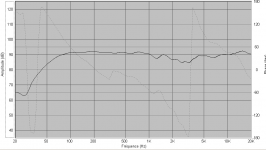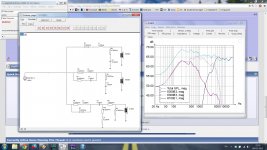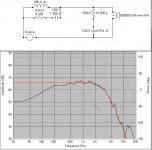I've got 4 Peerless HDS 6½" (830883) and 2 Peerless HDS 1" (810921) that I want to use for something.
Since these are almost the same drivers that Troels Gravesen uses in his 2½-way Nomex build I figured I would give it a go. (He uses the 830875 midwoofer instead)
(Link to build: PEERLESS-NOMEX-164)
My question is: How would you tune the crossover for the new driver? Normally a new woofer would require a complete change of the XO, but these woofers are quite alike. The frequency-response is pretty much the same, but the 830875 model seems to rise in impedance after around 1 kHz more than the 830883.
Datasheets:
http://www.tymphany.com/files/HDS-P830875%20Rev1_0.pdf
http://www.tymphany.com/files/HDS-P830883%20Rev1_0.pdf
Best regards
Peter
Since these are almost the same drivers that Troels Gravesen uses in his 2½-way Nomex build I figured I would give it a go. (He uses the 830875 midwoofer instead)
(Link to build: PEERLESS-NOMEX-164)
My question is: How would you tune the crossover for the new driver? Normally a new woofer would require a complete change of the XO, but these woofers are quite alike. The frequency-response is pretty much the same, but the 830875 model seems to rise in impedance after around 1 kHz more than the 830883.
Datasheets:
http://www.tymphany.com/files/HDS-P830875%20Rev1_0.pdf
http://www.tymphany.com/files/HDS-P830883%20Rev1_0.pdf
Best regards
Peter
Last edited:
Set the .5 woofer to the baffle step -3dB point??
Use that point ( impedance ) for the inductor value.
Use that point ( impedance ) for the inductor value.
That's amazing, Peter. The two woofers are almost identical! 🙂
All I see that is much different is your units have lower voicecoil inductance and 2dB less sensitivity. They both have a peak at 4kHz which is corrected by the 0.68mH/1uF tank.
Alan Yates' Laboratory - VK2ZAY's Engineering Calculators - LCR Resonance
That means they will rolloff very slightly faster than Troels' units which will create a marginal (correctable) midrange suckout. The Peerless 810921 tweeter seems to be identical to the Scanspeak D2608/9130 by some weird marketing ploy. There's probably a Vifa equivalent if my suspicions are right too. 😀
I think you can just go ahead with this with some TINY corrections for dimensions and hole size which you can check when you get to cut and drill the baffle.
I'd guess you want R2021 to be 3.3 Ohms to correct the suckout, R1051 to be 2.2 ohms, R1061 to be 10 ohms to get the levels right. 😎
All I see that is much different is your units have lower voicecoil inductance and 2dB less sensitivity. They both have a peak at 4kHz which is corrected by the 0.68mH/1uF tank.
Alan Yates' Laboratory - VK2ZAY's Engineering Calculators - LCR Resonance
That means they will rolloff very slightly faster than Troels' units which will create a marginal (correctable) midrange suckout. The Peerless 810921 tweeter seems to be identical to the Scanspeak D2608/9130 by some weird marketing ploy. There's probably a Vifa equivalent if my suspicions are right too. 😀
I think you can just go ahead with this with some TINY corrections for dimensions and hole size which you can check when you get to cut and drill the baffle.
I'd guess you want R2021 to be 3.3 Ohms to correct the suckout, R1051 to be 2.2 ohms, R1061 to be 10 ohms to get the levels right. 😎
Attachments
Hey Steve, thanks for your response!
I was also quite surprised (and happy) to see that the two tweeters are in fact the same 🙂
Good idea to adjust the zobel network, that makes sense. Im not quite sure about the attenuation of the tweeter. Troels says that the R1061 is optional - just by looking at the graphs it acutally looks better without, but if the 830883 model is slightly less efficient maybe I should just put it in and that will level things out?
Anyways thanks a lot for your help, I think I will try with 3.3 ohms for the zobel!
/Peter
I was also quite surprised (and happy) to see that the two tweeters are in fact the same 🙂
Good idea to adjust the zobel network, that makes sense. Im not quite sure about the attenuation of the tweeter. Troels says that the R1061 is optional - just by looking at the graphs it acutally looks better without, but if the 830883 model is slightly less efficient maybe I should just put it in and that will level things out?
Anyways thanks a lot for your help, I think I will try with 3.3 ohms for the zobel!
/Peter
I haven't had time to do much about my project, but I have bought the wood for the cabs. I'm going with a slight change of the cabinet, because I want to give curved cabs a go. Something a bit like the Illumina-66 (Illumina-66), but scaled to the right volume and front baffle (ofc).
A few questions remain about the crossover tho. Reducing the impedance correction circuit (due to the lower voice coil inductance) and maybe attenuating the tweeter a bit seems very logical, but what about the filter for the bass driver?
Shouldn't the filter for the bass driver be changed in some way as well? The driver I will use (830883) has an Re of 5.9 ohm (0.5 ohm lower than the 830875) and Le of 0.18 mH (compared to 830875's Le of 0.41 ohm).
Following standard procedures to calculate impedance correction circuits (zobel networks)
R_zobel = 1.25 * Re
C_zobel = Le / (1.25*Re)^2
would suggest a slightly lower value of R_zobel and a much lower value of C_zobel, but than again, it's obvious that Troels didn't use these equations to get the values in the first place..
I don't really know where to go from here, and I really want to be sure before investing in expensive crossover components. Help or/and comments on the importance of these changes would be greatly appreciated!
A few questions remain about the crossover tho. Reducing the impedance correction circuit (due to the lower voice coil inductance) and maybe attenuating the tweeter a bit seems very logical, but what about the filter for the bass driver?
Shouldn't the filter for the bass driver be changed in some way as well? The driver I will use (830883) has an Re of 5.9 ohm (0.5 ohm lower than the 830875) and Le of 0.18 mH (compared to 830875's Le of 0.41 ohm).
Following standard procedures to calculate impedance correction circuits (zobel networks)
R_zobel = 1.25 * Re
C_zobel = Le / (1.25*Re)^2
would suggest a slightly lower value of R_zobel and a much lower value of C_zobel, but than again, it's obvious that Troels didn't use these equations to get the values in the first place..
I don't really know where to go from here, and I really want to be sure before investing in expensive crossover components. Help or/and comments on the importance of these changes would be greatly appreciated!
The Peerless 810921 tweeter seems to be identical to the Scanspeak D2608/9130 by some weird marketing ploy.
As far as I am aware, when the 810921 was first released it was made by scanspeak for peerless (both were under tymphany at the time). Then Tymphany moved production to china and scanspeak broke off from tymphany. Peerless continue to make the 810921 in china using the same parts and scan, having split off, offer their own original version that is still built in house. The two products are identical, except if you buy the version from scan you also get their quality control.
I have been referring to this tweeter simply as the 'HDS tweeter' (as Zaph does), although it is now sold as a Scan-Speak. But I do not see it offered by Peerless on their website...?
Last edited:
Hi, pegodk
http://www.diyaudio.com/forums/multi-way/23208-system-pictures-description-226.html#post3395808
Very nice build 🙂
You can have a look at mine :
Construction d'enceintes "Nomex 164" - Le blog de pguerin
Concerning the dip at ~3.3 Khz, it's also present on my speaker but not so deep, i've also done measurement :

Decreasing the value of C2021 can be the way to go 🙂
If you can simulate, the crossover target slope of the upper woofer on the Nomex164 is 90 dB, LR24 at 3.3 Khz.
http://www.diyaudio.com/forums/multi-way/23208-system-pictures-description-226.html#post3395808
Very nice build 🙂
You can have a look at mine :
Construction d'enceintes "Nomex 164" - Le blog de pguerin
Concerning the dip at ~3.3 Khz, it's also present on my speaker but not so deep, i've also done measurement :
Decreasing the value of C2021 can be the way to go 🙂
If you can simulate, the crossover target slope of the upper woofer on the Nomex164 is 90 dB, LR24 at 3.3 Khz.
Attachments
Last edited:
Hey Pascal and thank you 🙂
I do have LspCAD and I have tried to experiment, but I dont get a result simillar to what I have measured. When I invert the tweeter and set the z-offset of the tweeter to 20 mm I get this result, which seems simillar (but with the tweeter inverted..?!)
I am not very familiar with LR-slopes, what does LR24 mean? My optimizer in LspCAD doesn't seem to work, so I cant fit my response to a certain slope
I do have LspCAD and I have tried to experiment, but I dont get a result simillar to what I have measured. When I invert the tweeter and set the z-offset of the tweeter to 20 mm I get this result, which seems simillar (but with the tweeter inverted..?!)
I am not very familiar with LR-slopes, what does LR24 mean? My optimizer in LspCAD doesn't seem to work, so I cant fit my response to a certain slope
Attachments
Hi,
The right word is LR4 maybe, I wanted to say Linkwitz–Riley crossover 24 db/octave slope.
Linkwitz?Riley filter - Wikipedia, the free encyclopedia
If you have mesured your drivers you can use a simulator or an optimiser to get the right values to get the target slope. I use SpeakerWorkshop.
You can even send me the files , i will do the simulations 🙂
PM me !
By the way R2011 and C2011 are not zobel network on Troel's crossover, they are part of the low pass crossover with L2011.
R2012 and C2011 are "tuning" the low pass in order to get the target curve.
I am not very familiar with LR-slopes, LR24 mean?
The right word is LR4 maybe, I wanted to say Linkwitz–Riley crossover 24 db/octave slope.
Linkwitz?Riley filter - Wikipedia, the free encyclopedia
If you have mesured your drivers you can use a simulator or an optimiser to get the right values to get the target slope. I use SpeakerWorkshop.
You can even send me the files , i will do the simulations 🙂
PM me !
By the way R2011 and C2011 are not zobel network on Troel's crossover, they are part of the low pass crossover with L2011.
R2012 and C2011 are "tuning" the low pass in order to get the target curve.
Hey Pascal
Thank you for your help, its much appreciated!
I have downloaded speaker workshop now, but its a whole new program to get used to, so i would like you to take a look if you have the time 🙂
Attached are frequency response of both the 830883 and 810921 unit mounted in cabinet, and the impedance characteristics in cabinet as well. I also have impedance measurements for the units in free air if you would like?
The frequency measurements were done in REW, with the mic 1 m away on axis. The response were than filtered to avoid reflections by adjusting the impulse response window to 10 ms. Im not quite sure that this is the most optimal way of measuring, but if should produce usable data.
I can upload the data in REW format if you are familiar with that program 🙂
Best regards
Peter
EDIT: Because of file sizes I cannot attach them to this post.. I have however uploaded them to my half-finished and outdated google.site:
https://sites.google.com/site/diyloudspeakerprojects/home/nomex-21-2-way-floorstander
Thank you for your help, its much appreciated!
I have downloaded speaker workshop now, but its a whole new program to get used to, so i would like you to take a look if you have the time 🙂
Attached are frequency response of both the 830883 and 810921 unit mounted in cabinet, and the impedance characteristics in cabinet as well. I also have impedance measurements for the units in free air if you would like?
The frequency measurements were done in REW, with the mic 1 m away on axis. The response were than filtered to avoid reflections by adjusting the impulse response window to 10 ms. Im not quite sure that this is the most optimal way of measuring, but if should produce usable data.
I can upload the data in REW format if you are familiar with that program 🙂
Best regards
Peter
EDIT: Because of file sizes I cannot attach them to this post.. I have however uploaded them to my half-finished and outdated google.site:
https://sites.google.com/site/diyloudspeakerprojects/home/nomex-21-2-way-floorstander
I may be a bit late to the party but i have a couple crossovers for these two drivers in an MTM configuration and a center channel MTM. i can email them to you if interested.
David
David
I would like to see it out of curiosity, but I probably wont rebuild the crossovers because they work so well 🙂
Hi Peter,
.frd in a cabinet is what I need, concerning the .zma I think the impedance measurement between free air and the cabinet version are not much different arourd the crossover point. You could put them also for downlaod.
I will do the simulation in a few days.
Attached are frequency response of both the 830883 and 810921 unit mounted in cabinet, and the impedance characteristics in cabinet as well. I also have impedance measurements for the units in free air if you would like?
.frd in a cabinet is what I need, concerning the .zma I think the impedance measurement between free air and the cabinet version are not much different arourd the crossover point. You could put them also for downlaod.
I will do the simulation in a few days.
Hi Peter,
I will do the simulation in a few days.
Running quickly SW optimiser with the .frd and .zma files provided fora target curve L-R 4 at 3300 Hz, here what I get :
You could try first to suppress R2021 wich has a very low value in the simulates crossover. This should give you ~2 dB more in the 2000/3500 Hz area. In a second time, you could change R2012 + C2011 to 1.2 mF and 8 ohms.
It would be interresting to measure the effects of this mods 🙂
but I probably wont rebuild the crossovers because they work so well 🙂
Modification proposed are minor in fact, you could also try to lower the tweeter SPL, my LPAD values are 1.2 ohms-15 ohms.
From the datasheet, the 830883 has a lower sensitivity around 1.5 dB less than the 830875.
Attachments
Last edited:
That looks amazing! Thanks a lot! Must learn how to use speaker workshop 🙂
So the tweeter is also filtered for LR4 at 3300 hz? Would definitely be interesting to try this modification and see if it improves the dip. I still fear that the dip is more related to the phase than to the slopes.
My 0.68 mH coil has a resistance of 0.22 Ohm, can you include that in the simulation? 🙂
So the tweeter is also filtered for LR4 at 3300 hz? Would definitely be interesting to try this modification and see if it improves the dip. I still fear that the dip is more related to the phase than to the slopes.
My 0.68 mH coil has a resistance of 0.22 Ohm, can you include that in the simulation? 🙂
That looks amazing! Thanks a lot! Must learn how to use speaker workshop 🙂
So the tweeter is also filtered for LR4 at 3300 hz? Would definitely be interesting to try this modification and see if it improves the dip. I still fear that the dip is more related to the phase than to the slopes.
I agree part of the dip is certainly related to phase.
But "flat" curve is also sometime not pleasant.
Yes the tweeter is also filtered for LR4 at 3300 hz, Troels use a non classical topology for the highPass.
My 0.68 mH coil has a resistance of 0.22 Ohm, can you include that in the simulation? 🙂
It has almost no visible impact on the SPL curve (less than 1/4 dB!)
SW is an old software, but it has a powerfull fonctionnalities and it is free.
LPCAD can certainly do more with a more friendly toolbox 🙂
I'll be back in a few days, time to test and measure !!
PS : try LPAD values 1.5 ohms-10 ohms to get ~1 db less SPL on the tweeter
Last edited:
I may be a bit late to the party but i have a couple crossovers for these two drivers in an MTM configuration and a center channel MTM. i can email them to you if interested.
David
PM or email your address, i can't attach to a PM.
Unless someone can quickly explain how to post them here in the thread. I can't figure it out.
David
- Status
- Not open for further replies.
- Home
- Loudspeakers
- Multi-Way
- Peerless 2½-way- Crossover tuning



